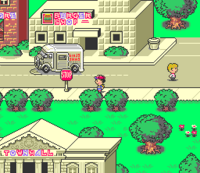
|
There are 169 stubs for enemies. Help out by expanding these pages! Item pages are now going to be split. See WikiBound:Projects for more information. |
|---|
EarthBound (series)
- This article is about the EarthBound/Mother series as a whole. For the individual game, see EarthBound.
| EarthBound マザー MOTHER | |
 International logo of the EarthBound franchise | |
 Japanese logo | |
| First installment | EarthBound Beginnings/Mother (1989) |
|---|---|
| Latest installment | Mother 3 (2006, Japan only) |
| Games | EarthBound Beginnings/Mother EarthBound/Mother 2 Mother 1+2 Mother 3 |
The EarthBound series, known as the Mother series in Japan (マザー MOTHER) and as the Earth Adventure series in China (地球冒险 Earth Adventure [1]}, is a series of role-playing video games published by Nintendo. There are three games in the series. EarthBound Beginnings, EarthBound, and Mother 3 have been released on the Nintendo Entertainment System, Super Nintendo Entertainment System, and Game Boy Advance respectively. Only Mother 3 has been released exclusively in Japan. The franchise debuted in Japan on July 27, 1989 with Mother (EarthBound Beginnings in English) for the Family Computer. In North America and Europe the series debuted with EarthBound (Mother 2 in Japan), released in North America on June 5th, 1995 for the Super Nintendo Entertainment System, then later in Europe on July 18, 2013 for the Wii U. Characters, music, weapons, and locations from the series also appeared in the Super Smash Bros. series, with Ness and Lucas being playable characters.
The EarthBound series has obtained a massive following and is widely seen as a cult classic. The re-releases of the games in particular has become among Nintendo's best-selling downloadable games, with EarthBound commonly seen as a best seller.
Etymology
The series' Japanese title, Mother, was inspired by a song of the same name by John Lennon. The lyrics of "Mother" deal with Lennon's experience of growing up without a father. EarthBound creator Shigesato Itoi chose this name for his project because his own father was absent through much of his life. This theme is addressed in the first two Mother games, in which the main protagonist's father is never seen and only makes an appearance as a voice on a telephone. Itoi also felt the title of Mother was especially fitting as the game series was more feminine than other RPGs. [2]
The origin of the name "EarthBound" came from Mother's English localization team in 1990, when its head, Phil Sandhop, thought of the name "Earth Bound" (stylized as EARTH BOUND) while on a bullet train to Kyoto. Beforehand, the team considered using the Mother moniker for the English localization, even going so far as to trademark the name in America on November of 1989 [3], but Phil Sandhop thought that it wouldn't work well as a title for the game in America; after coming up with Earth Bound, Phil Sandhop and the team ultimately decided upon the name after it stuck. [4] Later on in 1995, the team behind the English translation of Mother 2 decided to carry over the Earth Bound (now changed to a one-word "EarthBound") moniker in their English translation, as the English translation for Mother was never released in America by Nintendo until 2015, when they released it under the name "EarthBound Beginnings".
Franchise history

The series was created by an influential Japanese copywriter, actor, and minor television celebrity named Shigesato Itoi, who took part in Nintendo's video game industry in the late 1980s. After forming his own subsidiary Ape Inc. with then-Nintendo president Hiroshi Yamauchi, he began working on the franchise starting with Mother, later released internationally as EarthBound Beginnings. Released in July of 1989, the game took on a different theme as opposed to the medieval sword-and-sorcery theme found in most RPG games at the time. Instead, the game was set in modern-day America with the cast consisting of average children with psychic powers, using average everyday items such as baseball bats and frying pans as weapons. Mother was a commercial success in Japan, and so the game was then planned to be translated and released internationally with the title Earth Bound. Though the English localization was fully completed in September of 1990 [5] and was scheduled to release in the Fall of 1991, it was cancelled for a multitude of reasons, the largest one being the upcoming Super Nintendo Entertainment System, which was thought to overshadow the English release of the game. Thus, the game was decided too costly to market and produce (despite all of the packaging materials for the game being finalized and ready for production [6]) and was indefinitely shelved with no plans for a future release, with a dual U.S. and Canadian release being briefly considered in 1994.[7] On June 15th, 2015, the game was released for the first time internationally to celebrate the 20th anniversary of the series in North America, with the game being given the official title EarthBound Beginnings. Similar to Japan, the game received positive reception, with critics praising EarthBound Beginning's originality, story, and music. However, the game did receive criticism for its difficulty and balance issues, especially the difficulty at Mt. Itoi and the game’s high random enemy-encounter rate.
With the success of Mother, Shigesato Itoi began to work on a sequel for the Super Famicom, Mother 2. However, the game endured numerous internal delays, with the game’s total development taking 5 years; at one point, the game faced the prospect of cancellation. However, the project was saved when veteran programmer Satoru Iwata joined the development team, making the Mother 2 project now a joint effort by Ape and HAL Laboratory (HALKEN at the time), separate studios based at separate locations (employees would regularly have to travel between studios to work). The game was then completed and released in Japan in August 1994. Mother 2 was then localized and released in North America on June 5th, 1995 as EarthBound. While the game was a critical and commercial success in Japan, it received poor reception in America. During the time of EarthBound's release, the RPG genre was generally unpopular in the west (this eventually changed with the release of Final Fantasy VII), and the game was criticized by multiple gaming sources and magazines for having simple, cartoonish graphics as opposed to the advanced graphics that were more appealing at the time in games such as Killer Instinct and Chrono Trigger. EarthBound's unusual, expensive, off-kilter, and bizarre marketing campaign, "This Game Stinks", is also thought to be one of the leading causes for the game's failure in America, which was styled after the slime-based gross-out humor of the 90s primarily displayed in Nickelodeon shows such as The Ren & Stimpy Show and which many fans felt did not complement the unique and wacky style of the game; gaming magazine GamePro also received numerous complaints about the ad campaign and its foul-smelling scratch-n'-sniff stickers more than any other ad campaign that year alone. EarthBound's poor American sales prevented the game from being released in PAL regions.
Despite this, the game began to receive recognition because of Ness, the protagonist of EarthBound, receiving representation in the 1999 Nintendo 64 title Super Smash Bros. and its successors. Because of this, the game began to receive a large following on internet fan sites such as Starmen.Net (originally EarthBound.Net) and EarthBound Central. In addition, a finished prototype copy of the English version of Mother was found on eBay and was eventually dumped online by the hacker group Neo Demiforce in 1998 under the name "EarthBound Zero" (17 years before the game would be officially released by Nintendo as EarthBound Beginnings), bolstering the EarthBound fan community even further and simultaneously popularizing the concept of preserving unreleased video games with one of the first-ever unreleased first-party prototype titles. Retrospectively, EarthBound became a massive success, with critics calling it not only one of the best RPGs of all time, but also the most original. The game received praise for its quirky humor and its many parodies of American culture. After Nintendo received massive outcries from the EarthBound fanbase to get the game released for the Wii U's Virtual Console service on sites like Nintendo's own Miiverse, the game was released on the service in Japan on March 20th, 2013, with an international release releasing on July 18th, 2013. The Wii U Virtual Console release of the game was the first time the game was released in PAL regions, and it was one of Nintendo's most popular downloadable games of all time.
After the release of Mother 2, Itoi began on a sequel to the game, Mother 3 (named EarthBound 64 by western fans, and Mother 64 by Eastern fans). The subtitle used in the Japanese game was changed several times during development, with the first being Forest of the Chimera (森のキマイラ), but the most common (and last) one being Fall of the Pig King. Initially developed for the Super Famicom (and planned for its CD-ROM add-on before it was cancelled), development was halfway completed before moving to the 64DD disk drive add-on for the Nintendo 64, where it was planned to utilize the add-on’s advanced capabilities; it was also planned to be a launch title for the add-on in Japan. When the disk drive's repeated delays made its future as a viable commercial accomplishment uncertain, the development moved to the N64 console with its cartridge-based format. EarthBound 64 featured 3D graphics as opposed to the 2D art style from the previous 2 games. However, the development team faced many difficulties, forcing the game to have numerous delays across the years of the N64 lifespan. One of the biggest difficulties was how Itoi and his team were inexperienced with developing 3D video games, which was eventually alleviated with outside help and the assistance of the team which worked on HAL's Pokémon Stadium. While development was steadily progressing along at a healthy pace, with a fully playable demo even appearing at Space World 1999, further developmental progress would have meant taking away much-needed resources from Nintendo's upcoming console, the Nintendo GameCube. Additionally, the team also struggled with reducing the scope of the game to fit the Nintendo 64's hardware limitations, with Itoi considering reducing entire sections of the game’s story into a series of images and music. After more delays, the 30-60% game was officially cancelled on August 22nd, 2000, with Itoi citing that he did not want to make anything other than "something truly special" in addition to the project becoming too complex with its interest in 3D graphics.
However, after the success of the Super Smash Bros. series, encouragement from fans eventually led to Shigesato Itoi returning to development on Mother 3 for the Game Boy Advance, which was co-developed with HAL Laboratory and Brownie Brown. During this time in the Summer of 2003, the director of Namco's Baten Kaitos: Eternal Wings and the Lost Ocean, Yasuyuki Honne, met up with then-NCL president Satoru Iwata and Itoi to propose a joint venture with Namco to produce a new Mother title, which would use a felt-like art style and feature Ness/Ninten as the main protagonist. Itoi was uninterested (and was initially "flabbergasted"), though he eventually grew to like the felt recreation of 1980s America. [8] To promote the revival of Mother 3, Mother and Mother 2 were ported to the Game Boy Advance in June 2003, being the compilation cartridge Mother 1+2, released only in Japan. The Mother portion featured all of the changes that were made in the then-unreleased English prototype of EarthBound Beginnings, while most of Mother 2 remained the same aside from the drop in audio quality due to hardware limitations. A commercial for the game featuring Mr. Saturn ended with the caption "We're making Mother 3 for the Game Boy Advance too. Dakota!". On April 20th, 2006, Mother 3 was finally released in Japan on the Game Boy Advance, featuring the same story, characters, and settings as its Nintendo 64 counterpart. The Game Boy Advance version returned to the 2D pixelated art style that was used in the previous games.
Mother 3 remained exclusive to Japan without an official localization, making it the only installment in the series without an official English release to this day. Despite this, the fan website Starmen.Net created a fan translation led by Clyde "Tomato" Mandelin, which released on October 17th, 2008 along with a full-color, lavishly illustrated 272-page Handbook to accompany the translation in the vein of the EarthBound Player’s Guide. The fan translation received strong positive reception from fans, receiving 100,000 downloads within the first week of its release. Mother 3 received strong critical acclaim in the west with praise to the rhythm-based RPG combat, but more so on the storyline and tragic events that were rarely seen in its predecessors.
With Mother 3 finally complete, Shigesato Itoi decided that Mother 3 was the official conclusion of the series, and has stated that he has no plans to create a fourth Mother installment in the future.
Legacy
The EarthBound series was initially seen as a minor classic Nintendo title in the west, despite its popularity in Japan. When EarthBound was released on the Wii U's Virtual Console, however, it became one of Nintendo's best selling downloadable games of all time.
The recognition began when Ness was included in Super Smash Bros. on the Nintendo 64 and became a staple in the series. Ness's inclusion in Super Smash Bros. Melee was widely applauded and fans were excited to see him return. Throughout the years between the initial release of EarthBound and its virtual console rerelease, the series had a massive following that continued grow larger thanks to the representation of the series in the Super Smash Bros. series. During the Wii era EarthBound was one of the most requested titles for the Wii Virtual Console. When Mother 2 was released on Japan's Wii U Virtual Console, the demand for EarthBound to be released in other countries grew all the more. Eventually when it was released, it was revealed that one of the main reasons for releasing it was because of the massive fan outcry on places like Miiverse.
The success of the series in the west caused the original Mother to be released outside of Japan for the first time, under the name EarthBound Beginnings, to commemorate the 20th anniversary of the EarthBound's release in America. The game was highly applauded similar to EarthBound's release with fans expecting Mother 3 to be officially localized and released on the Virtual Console next.
Despite Mother 3 not receiving an official English release, the EarthBound series is now seen as a mainstream franchise in gaming culture rather than staying as a minor Nintendo classic. EarthBound in particular is widely viewed as the best example of a cult classic. Many EarthBound references and cameos began to appear in many other Nintendo games, ranging from Ness and Lucas appearing as mystery mushroom power-ups in Super Mario Maker, to an entire EarthBound-themed level in Kirby Planet Robobot, and continues to be an important franchise represented in the Super Smash Bros. series. The series has grown to the point where it has spawned fan games such as Mother: Cognitive Dissonance, as well as numerous indie games that took inspiration from the series, a prime example being the critically acclaimed Undertale.
Gameplay
The gameplay of the series involves the player traveling through an overworld screen. They can travel in any direction, provided the path isn't blocked, and will be challenged by enemies, most of which will move toward the player. A new screen appears during the fight, with there being many options to select in order to battle their opponent. Also listed is the amount of HP the character has left. If they beat the enemy, the fight will end and the game will return to the overworld screen.
Games
| Title | |
|---|---|
| Cover, original release and system | Description |
| EarthBound Beginnings | |
 July 2nd, 1989: Japan June 14, 2015: International (Virtual Console) Nintendo Entertainment System |
Also known as Mother, EarthBound Beginnings is the first game to be released in the EarthBound series. It follows the adventures of Ninten, Lloyd, Ana, and Teddy trying to find the Eight Melodies scattered across America in order to subdue the evil alien Giygas and his intentions of destroying all human life on Earth. It was released in Japan on July 27th, 1989. After an official English localization (Earth Bound) was completed in 1990 but never saw its initial release in 1991, it was released via the Virtual Console service on the Wii U on June 14, 2015, under the official title "EarthBound Beginnings". |
| EarthBound | |
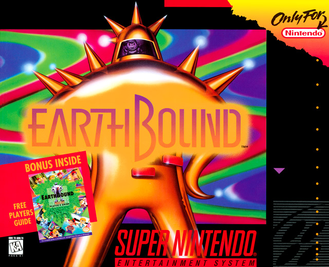 August 27, 1994: Japan July 2, 1995: North America July 18, 2013: Europe and Oceania (Virtual Console) Super Nintendo Entertainment System |
Also known as Mother 2, EarthBound is the sequel to Mother in which four children of prophecy, Ness, Paula, Jeff and Poo (The Chosen Four), team up to defeat the power-corrupted Giygas and save the universe from eternal darkness. Released on August 27th, 1994 in Japan, it is also the only game to be physically released outside of Japan by Nintendo, releasing in North America on June 2nd, 1995. Following a March 20th, 2013 re-release on the Japanese Wii U Virtual Console, it was released internationally for the Wii U Virtual Console service on July 18th, 2013, marking the first time the series was ever released officially in PAL regions. |
| Mother 3 | |
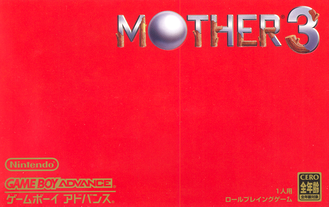 April 20th, 2006: Japan October 17, 2008: Fan Translation Game Boy Advance |
The final game in the Mother series, Mother 3 follows the adventures of another group of heroes, including Lucas, Kumatora, Duster, and Lucas' dog Boney as they attempt to save the Nowhere Islands from a strange pig-themed army. It was released on April 20, 2006 in Japan; however, it was never released anywhere else. Despite its Japan-only release, a fan translation was created. Since Mother 3's release, it has seen a very strong fan effort to try to get the game released outside of Japan. It was re-released on December 17, 2015 on the Virtual Console for the Wii U, though only in Japan. |
Ports
| Title | |
|---|---|
| Cover, original release and system | Description |
| Mother 1+2 | |
 June 20th, 2003 (Japan) Game Boy Advance |
Mother 1+2 is a port of the Japanese versions of EarthBound Beginnings and EarthBound on the Game Boy Advance, containing various tweaks to audio and graphics to suit the Game Boy Advance's style, screen size, and hardware limitations. While the Mother port is a near-exact Japanese translation of the English "Earth Bound" version, the Mother 2 port has minimal graphic and audio changes. It was released in Japan on June 20th, 2003 to hype players for the release of Mother 3. It was never released outside of Japan, likely due to the original Mother being unreleased outside of Japan at the time. |
Unreleased Titles
| Title | |
|---|---|
| Screenshot/concept art, status, and system | Description |
| EarthBound 64 | |
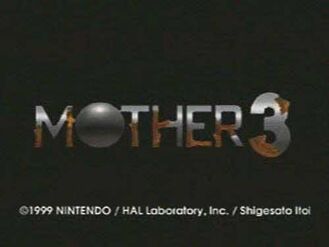 Cancelled (Worldwide) Nintendo 64DD/Nintendo 64 |
EarthBound 64, or Mother 3: Fall of the Pig King is an unreleased version of Mother 3 for the Nintendo 64, originally planned to be the primary version of the game until the title's cancellation. While the development cycle was initially plagued with problems, as creator Shigesato Itoi and his development team were unfamiliar with programming 3D graphics; the project's development improved exponentially as the team received outside help with programming the game. Despite development progressing at a smooth and steady pace, the game was ultimately cancelled on August 22nd, 2000, due to further developmental progress potentially taking away needed resources from the Nintendo GameCube's development. The project was ultimately revived for the Game Boy Advance and released in 2006 as Mother 3. |
| Untitled EarthBound game (Nintendo GameCube) | |
 Undeveloped Nintendo GameCube |
In the Summer of 2003, the director of Baten Kaitos: Eternal Wings and the Lost Ocean, Yasuyuki Honne, met with Satoru Iwata and Shigesato Itoi to discuss making an EarthBound game for the Nintendo GameCube, with Namco as the developer. The concept art that Honne brought with him depicted the game's graphics being made entirely out of a felt art style, with the protagonist of the game being Ness. While Itoi was not interested in developing the project, he grew to like the 1980s felt recreation of America by the end of the proposition. |
Common elements
All games feature protagonists wearing striped shirts, and all are about collecting pieces to a song, often heard at the end of each game. Giygas appears as an antagonist in the first two games, and Porky Minch appears as an antagonist in the last two games.
Trivia
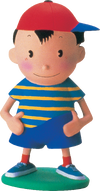
- The first two games in the Mother franchise have paper clay/papier-mâché/clay models of the main protagonists, some side characters (only for Mother 2), and most of the main enemy roster for each respective game.
References
- ↑ https://earthbound.fandom.com/wiki/Mother_(series)
- ↑ EarthBound - Did You Know Gaming? Feat. Chuggaaconroy. YouTube. Retrieved June 12, 2020.
- ↑ EarthBound - Did You Know Gaming? Feat. Chuggaaconroy. YouTube. Retrieved June 12, 2020.
- ↑ https://vimeo.com/ondemand/mothertoearth
- ↑ http://www.lostlevels.org/200407/200407-earthbound2.shtml
- ↑ https://vimeo.com/ondemand/mothertoearth
- ↑ http://www.lostlevels.org/200407/200407-earthbound2.shtml
- ↑ https://nintendoeverything.com/nintendo-and-namco-discussed-a-potential-earthbound-game-for-the-gamecube-concepts-shown/
by Shigesato Itoi |
||||||||||||||||||||||||||
|---|---|---|---|---|---|---|---|---|---|---|---|---|---|---|---|---|---|---|---|---|---|---|---|---|---|---|
| ||||||||||||||||||||||||||

|

| |||
|---|---|---|---|---|
Games • • Stages Onett • Fourside • New Pork City • Magicant Items Mr. Saturn • Franklin Badge • Ramblin' Evil Mushroom Assist Trophies Jeff • Starman Other Trophies • Stickers • Spirits | ||||
